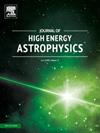Modified Compton effect and CMB anisotropy
IF 10.2
4区 物理与天体物理
Q1 ASTRONOMY & ASTROPHYSICS
引用次数: 0
Abstract
Recent satellite observations have revealed significant anisotropy in the cosmic microwave background (CMB) radiation, a phenomenon that had previously been detected but received limited attention due to its subtlety. With the advent of more precise measurements from satellites, the extent of this anisotropy has become increasingly apparent. This paper examines the CMB radiation by reviewing past research on the causes of CMB anisotropy and presents a new model (Modified-ΛCDM) to explain the observed temperature anisotropy and the anisotropy in the correlation function between temperature and E-mode polarization in the CMB radiation. The proposed model is based on a modified-generalized Compton scattering approach incorporating Loop Quantum Gravity (LQG). We begin by describing the generalized Compton scattering and then discuss the CMB radiation in the context of processes occurring at the last scattering surface. Our findings are derived from the latest observational data from the Planck satellite (2018) and recent Dark Energy Survey Instrument (DESI) baryon acoustic oscillation (BAO). In our model, besides the parameters available in the Planck data for the standard model (ΛCDM), we introduce two novel parameters: , the density of cosmic electrons, and , a parameter related to the modified-generalized Compton scattering effects. Utilizing Planck 2018 data (TTTEEE+lowE+lowT+lensing), the Modified-ΛCDM model estimates the best-fit values of and . A combined analysis incorporating Planck 2018, PantheonPlus sample and DESI BAO datasets yields and , demonstrating consistency between these datasets and first analyze using CMB. Increasing the values of and amplifies temperature anisotropy power spectrum fluctuations and temperature-E-mode correlation for multipoles , particularly near the first peak. Statistical analysis further highlights these effects, emphasizing the importance of modified Compton scattering on the integrated Sachs-Wolfe effect.
The results demonstrate compatibility with observational data and suggest that future high-precision experiments may refine constraints on and , potentially uncovering deviations from the standard model.
求助全文
约1分钟内获得全文
求助全文
来源期刊

Journal of High Energy Astrophysics
Earth and Planetary Sciences-Space and Planetary Science
CiteScore
9.70
自引率
5.30%
发文量
38
审稿时长
65 days
期刊介绍:
The journal welcomes manuscripts on theoretical models, simulations, and observations of highly energetic astrophysical objects both in our Galaxy and beyond. Among those, black holes at all scales, neutron stars, pulsars and their nebula, binaries, novae and supernovae, their remnants, active galaxies, and clusters are just a few examples. The journal will consider research across the whole electromagnetic spectrum, as well as research using various messengers, such as gravitational waves or neutrinos. Effects of high-energy phenomena on cosmology and star-formation, results from dedicated surveys expanding the knowledge of extreme environments, and astrophysical implications of dark matter are also welcomed topics.
 求助内容:
求助内容: 应助结果提醒方式:
应助结果提醒方式:


